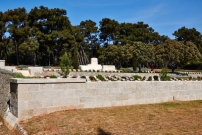| First Name: | Arthur James | Last Name: | GOODFELLOW | |
|---|---|---|---|---|
| Date of Death: | 07/08/1915 | Lived/Born In: | Chiswick | |
| Rank: | Captain | Unit: | Lancashire Fusiliers8 | |
| Memorial Site: | ||||
Current Information:Age-29 3, Fauconberg Mansions, Chiswick Pink Farm Cemetery, Helles, Gallipoli
Gallipoli 1915 On 25 April, British, Australian and New Zealand forces landed on the Gallipoli peninsula. The plan was that these forces would soon defeat a demoralised Turkish army, knock Turkey out of the war, open up the Mediterranean to the Russian navy and threaten Austro-Hungary from the south. None of these things were achieved despite nine months of hard fighting in terrible conditions. It was a heroic failure. By July, 1915, and after much fierce fighting, stalemate had set in at Gallipoli both at Cape Helles where the British and French had landed and at Anzac Cove where the Australian and New Zealand Corps were unable to break out of their beach head. Fresh troops were needed and they were on their way in the shape of four divisions from Britain and things were put on hold until they arrived. The plan for August was for a landing at Suvla Bay to the north of Anzac Cove whilst at the same time, the ANZAC Corps, reinforced by some of the new British troops would effect a breakout from Anzac Cove and establish a line across the peninsula. Whilst this was going on the troops in the south at Helles would stage a number of diversionary attacks. But it all went horribly wrong and much of the reason for this can be explained by inadequate planning and leadership. Nobody seemed to know what they were supposed to be doing and Lieutenant-General Stopford, in charge of the Suvla landings was particularly out of his depth. The landings at Suvla failed to link up with the forces at Anzac and the breakout from there did not happen despite valiant efforts by all concerned. The loss of life on all fronts was again enormous. L.A. Carlyon’s excellent book “Gallipoli” gives a superb yet chilling account of the events. The diversionary attack at Helles on 6th August, 1915 was made by 88 Brigade, 29th Division. Things did not go well from the start. When the British bombardment began in the afternoon the enemy immediately replied with their own artillery barrage which targeted the crowded British jump off trenches, killing and wounding many of those waiting to attack. At 3.50pm the troops went over the top only to find that their own barrage had been wholly inadequate and that the Turkish defences were still very much intact. Within a few minutes after zero hour, 88 Brigade had been shattered with two thirds of the attacking force becoming casualties and the few gains made were soon relinquished. 42nd Division tried again on the following day, 7th August. At 9.40am 127 and 125 Brigades attacked on an 800 yard front but they met the same problems and were equally unsuccessful. On the left 127 Brigade could make no progress and by noon they were back in their own lines after suffering many casualties. On the right the Turkish defences were weaker and the four battalions of 125 Brigade, which included 8th Lancashire Fusiliers, managed to reach the enemy’s second line but were then driven back by a counter attack. Most of the brigade fell back to their starting line but a detachment managed to hang on to a small vineyard just west of the Krithia road, which was eventually incorporated into the British front line. One of the many casualties suffered during this operation was Arthur Goodfellow of 8th Lancashire Fusiliers. |
||||
| « Back to Search Results | ||||
| If you think any of the information shown here is incorrect, Click Here to submit your amends and comments | ||||




